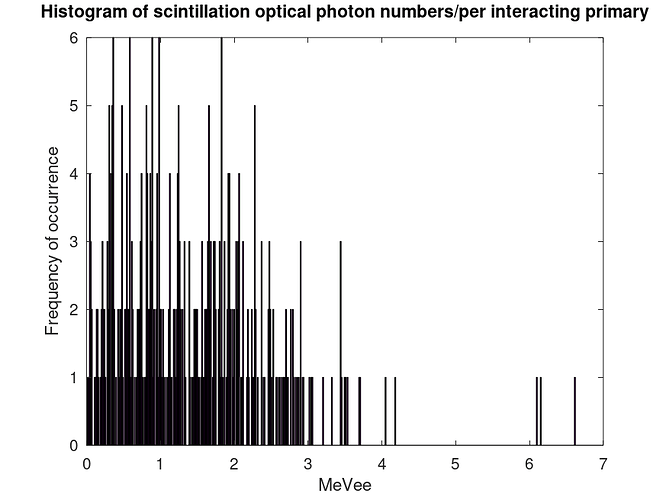Hello, I am trying to simulate a BGO scintillation crystal.
In the simulation, 4.4 MeV neutrons appear inside a BGO cylinder with a given momentum. I expect the neutrons to interact with the BGO producing gammas which produce scintillation light as they go through the crystal.
The problem is that I cannot see the scintillation light. I see many optical photons coming from Cherenkov light and some optical photons coming from a eIoni process, but no process such as scintillation appears.
I have given the BGO the right properties (or at least I think I have), as you can see below, but as I said, no light from scintillation shows up.
// BGO Optical Properties (MPT)
// Declare the MPT
G4MaterialPropertiesTable *BGO_mpt = new G4MaterialPropertiesTable();
// Define the energy region for optical properties
G4double BGO_energy[3] = {1*eV, 2.5*eV, 5.0*eV};
// Relative intensity of scintillation light over specified energy range
G4double BGO_SCINT[3] = {1., 1., 1.};
// Refractive index of BGO
G4double BGO_RINDEX[3] = {2.15, 2.15, 2.15};
// Absorption length of BGO for optical photons
G4double BGO_ABSL[3] = {1.118*cm, 1.118*cm, 1.118*cm};
// Add properties to the MPT
BGO_mpt->AddProperty("SCINTILLATIONCOMPONENT1", BGO_energy, BGO_SCINT, 3);
BGO_mpt->AddProperty("RINDEX", BGO_energy, BGO_RINDEX, 3);
BGO_mpt->AddProperty("ABSLENGTH", BGO_energy, BGO_ABSL, 3);
BGO_mpt->AddConstProperty("SCINTILLATIONYIELD", 8./keV);
BGO_mpt->AddConstProperty("RESOLUTIONSCALE", 1.0);
BGO_mpt->AddConstProperty("SCINTILLATIONTIMECONSTANT1", 300.*ns);
// BGO_mt->AddConstProperty("SCINTILLATIONTIMECONSTANT2", 45.*ns);
// BGO_mpt->AddConstProperty("SCINTILLATIONYIELD1", 1.0);
// Attach material porperties table to the material
BGO->SetMaterialPropertiesTable(BGO_mpt);
Maybe this is a physics error and not a programming error, or maybe I am just configuring the wrong way the BGO, but I would really appreciate some advice. Thank you in advance.
P.S.: Physics List is OK too, by the way.
